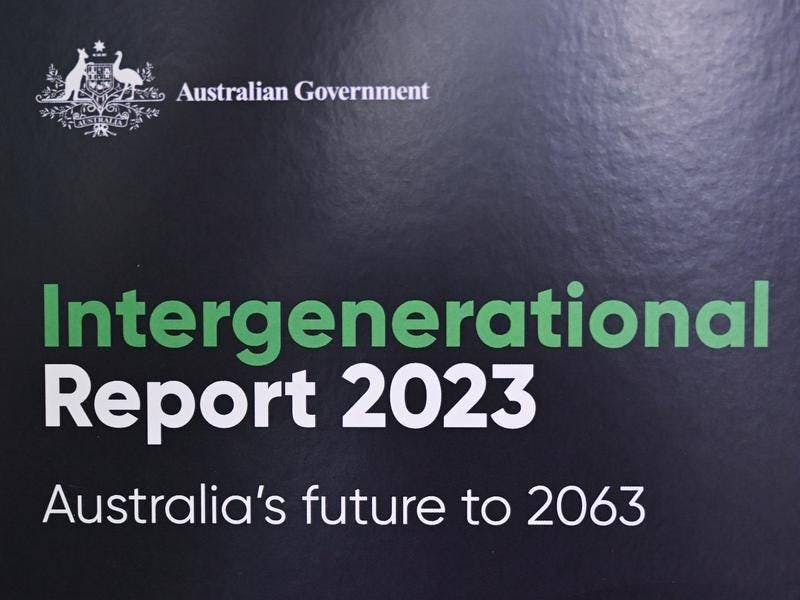Intergenerational Report forecasts a bleak future

Forty years from now, Australia will have fewer young people, who will be caring for more elderly people while struggling with unaffordable housing and declining living standards. It will frequently be too hot to step outside the house for work, and instead of spending money on services to improve this picture, the government will be forking out for a war with China, real or imagined.
This is the picture painted by the Treasury’s sixth Intergenerational Report, released in August—if not exactly in its words.
These reports, which were first commissioned by the Howard government in 2002, ostensibly exist to project social and economic changes 40 years into the future. In practice, they are partisan affairs that sway close to the issues the government of the day is already highlighting (for instance, there has been little mention of climate change in any Liberal government’s iteration of the report).
Also, social forecasts stretching decades into the future are bound to be off. Many key predictions from twenty years ago have already been proven incorrect or marked down in subsequent reports.
All of that aside, this one rings pretty true. The current situation for most young people and workers is already bleak, and with no serious attempts being made to improve things, the future is likely to look worse.
Take the ageing population. The report predicts that the median age will increase by 4.6 years to 43.1 in 2063 (after already increasing by eight years since the early 1980s), and that the share of the population aged over 65 will increase to nearly one-quarter. On the surface, this should highlight a few good things: health care has improved so people live longer, and women have greater access to birth control and more options for a life outside the home.
But if you look at the current state of aged care services, it is cause for concern. The industry is full of low-paid workers and has been plagued with abuse scandals. It is almost entirely privatised and stratified according to income and wealth. This will intersect with the housing affordability crisis (on which the report is conspicuously brief, the Albanese government trying to convince us they’re fixing it)—many aged care homes now require residents to sell their homes to buy into the facility. According to the last census, the home ownership rate of 30–34-year-olds had decreased to 50 percent, from 64 percent in 1971. This is the generation that will be retiring in 40 years.
It’s possible that the responsibility of caring for the elderly will be pushed back onto families. But they will be families with relatively lower incomes than today, according to the report. The average annual growth rate of income per person is projected to be 1 percent, compared to 2.1 percent over the past 40 years. But this assumes that all increases are shared equally across the population. According to the Australia Institute, between 2009 and 2019, the wealthiest 10 percent gained 93 percent of all income growth. It will take a monumental industrial battle to start to turn that around.
There are other bleak trends touched on in the report: a retirement system reliant on superannuation, of which young people increasingly have less; the impact of advances in tech and AI on the workforce (although on this, the report paints an unjustifiably rosy picture); and the increasing number of people who will rely on social services that degrade year after year.
But when thinking about the future, the overwhelming issue that underlines all others is climate change. The report focuses mainly on how climate change will affect labour productivity (how much stuff a worker produces in a given amount of time): after all, it’s published by the Treasury and primarily concerned with the health of Australian capitalism.
But rising temperatures and a greater frequency of catastrophic weather events will have a social cost that is still difficult to imagine fully. Wild bushfire seasons, unaffordable energy bills, unlivable suburbs and towns, climate refugees confronted with Australia’s militarised border and much more are all on the horizon—indeed, some of them are already here.
Then there are the shocks that could make it all much worse but are missing from Treasury’s assumptions. Another pandemic, an economic crash, a war between great powers—all of these are possible.
But the most glaring question to arise from musings on the future is: What is the government planning to do about any of this?
As it stands, nothing.
Labor’s housing policy will not even scratch the surface of the crisis. Despite many references in the report (38 in total) to a “net zero transformation”, the government is expanding the fossil fuel industry and emissions are rising. Instead of heavily investing to renationalise public services and distribute money back down to those who really need it, Albanese is pushing ahead with the Stage 3 tax cuts and increasing the military budget.
At this rate, our futures really will be spent huddled together inside rented homes to escape the searing heat while nuclear submarines patrol the borders.